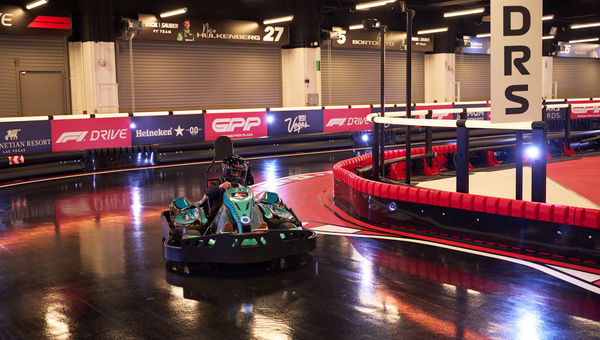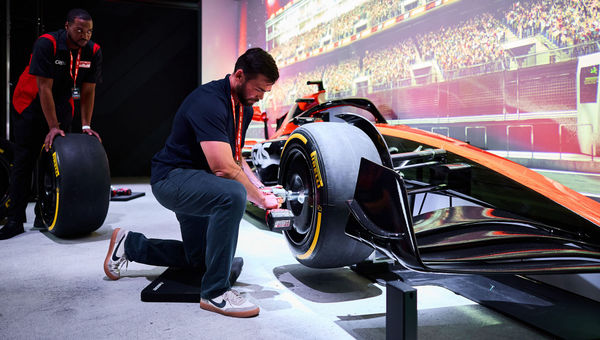New adrenaline-inducing attractions and cleverly conceived exhibits at Grand Prix Plaza in Las Vegas effectively deliver the sights, sounds and other sensations of Formula 1 racing.
The four-story, 300,000-square-foot building has been used as the garage, pits and viewing area for the past two years of the Las Vegas Grand Prix. In May, entertainment and amenities were introduced to make the site Formula 1’s largest and most compelling attraction in North America.
As guests of Grand Prix Plaza, my daughter, her fiance and I immediately received soft, black head socks, selected helmets, signed waivers and attended a safety briefing for the first of the attractions, F1 Drive.
I invited my daughter and her fiance because they have been fervent F1 fans for years, even before the race came to the Strip. The two got engaged earlier this year when they were in Japan to see a race there. The Netflix documentary “Formula 1: Drive to Survive” hooked them. The Brad Pitt film, “F1 the Movie,” which opened last month, will no doubt attract other followers.

Up to 20 drivers can race on the F1 Drive kart track at Grand Prix Plaza. Photo Credit: Powers Imagery
Start your engines
Dubbing myself “Paulster,” I settled into a Formula 1-inspired kart behind my companions and waited for the green signal. An employee reminded me to lower the helmet’s clear plastic shield over my eyes as I pressed the accelerator.
I heard the engines roar and the iconic F1 radio beeps to indicate completed laps. As many as 20 drivers can compete on the 1,696-foot, 31-turn track that briefly goes outdoors onto the Grand Prix’s actual pit lane.
On an early lap, I turned right sharply but then skidded to the left. The side of my kart slammed into a wall, and I stopped. Well protected from the collision, I regained my bearings and resumed. Soon I nodded to my future son-in-law as he gleefully passed me.
Strategy comes into play because the LED-lit steering wheel features a drag reduction system button, which like in real F1 racing promotes overtaking on certain sections of the track. The Energy Recovery System button also provides a rechargeable boost, reflecting real F1 tech that captures energy that would otherwise be lost in processes such as braking.
Times are recorded and displayed on data screens. Fast laps are celebrated, and racers compete not only against who’s on the track but also those who have raced that week and further out.
“Paulster” failed to make the podium.
F1 Drive’s karts can reach 30 mph, but they feel faster. My hands got sore from gripping the wheel, my arms were tired, my eyes tense, my concentration challenged. Drivers get a modest sense of the strength, hand-eye coordination, endurance and tenacity required of F1 drivers, who routinely reach speeds of 220 mph.

Guests can challenge themselves to change a tire in F1 time. How fast is that? 2.5 seconds. Photo Credit: Mike Kirschbaum
Time to downshift
Grand Prix Plaza balances the curiosities of F1 rookies like me and the enthusiasts like my guests. Cooling off from the karts, we walked into the next sprawling attraction, F1 X, which combines museum-quality presentations, interactive screens and other experiences. Guests learn about 75 years of F1 history, iconic cars, personalities, rules and scoring. Memorabilia of past and present teams, a replica of the F1 broadcast center and a guide to cars’ technical components were among the highlights.
Guests can also learn about power units, steering wheels, tires, aerodynamics and what drivers wear to help ensure comfort and safety. Three guests can team up to change a life-size tire. One handles the battery-powered wheel gun to loosen the nut, one removes the old tire, another hoists the new tire into place and the nut is tightened. Our best time was 7.3 seconds; precisely choreographed F1 teams typically do it in 2.5 seconds.
Using touch screens, guests choose the colors, design and even the sponsors for their perfect car. Lighting trained on a car’s white template displays what their unique scheme looks like. A 4-D theater with haptic seats, water sprays and simulated wind provides a feel of a few laps around the Las Vegas circuit from a professional driver’s perspective.
Finally, the simulators, or sims (free for the rest of July) combine advanced motion technology with immersive audiovisual effects for guests to race virtually on the Las Vegas circuit.
I tried to follow the highlighted path for the fastest route. I eventually learned to decelerate and brake at the right times, but not before several grim head-on crashes into the same troublesome wall. I could feel the consequences but not nearly as much as on the kart track.
The plaza also includes a sleek bar, the Fuel & Fork restaurant and merchandise store.
All the displays will be removed in mid-September for this year’s F1 race, which takes place Nov. 20 to 22. The store will move to the Grand Canal Shoppes at the Venetian Resort during that time, and the attractions will return in mid-December.
As I headed back home to suburban Henderson in a Chevy Impala, pushing 80 mph felt different. Whether it was the karts, the high-resolution videos or the sims, my perception of speed was briefly altered. I was glad to be home safe, with a new appreciation of professional race drivers and the sport of F1.
Grand Prix Plaza, open for group rentals, also hosts F1 watch parties with food and beverages inspired by that week’s host country. The attractions are open from 10 a.m. to 10 p.m. Sundays through Thursdays and from 10 a.m. to midnight Fridays and Saturdays. Attraction packages are available, and advanced ticketing is recommended (available at www.grandprixplaza.com).

